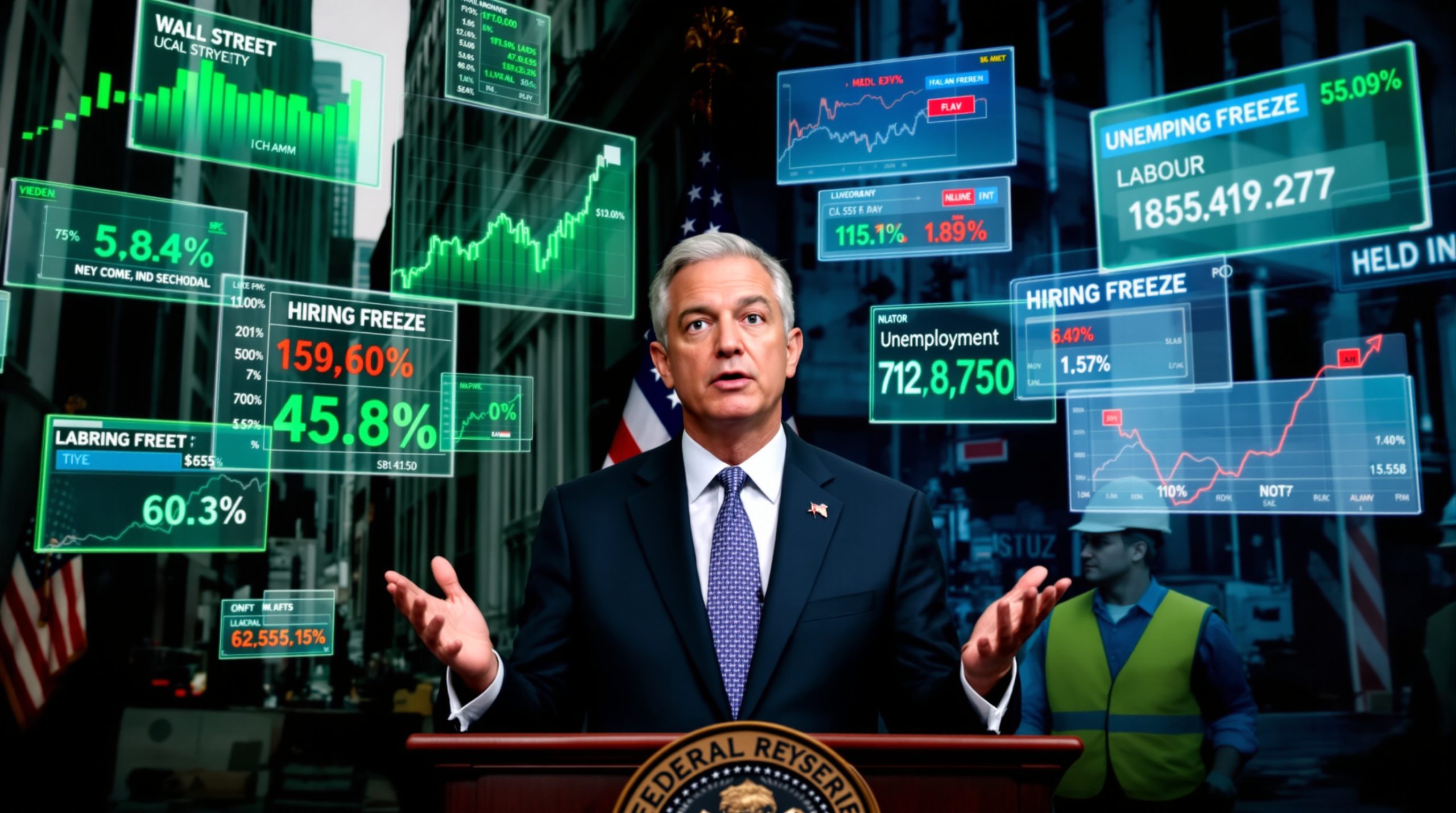How Economic Uncertainty Is Fueling Gold's Rally
The precious metal market is witnessing a remarkable ascent as gold prices continue their upward trajectory in 2025. With spot prices recently touching $3,445 per ounce, investors worldwide are turning their attention to this traditional safe-haven asset. This gold price surge represents fundamental shifts in the global economic landscape that extend beyond typical market fluctuations.
The Federal Reserve's Challenging Position
The Federal Reserve finds itself in a precarious situation, caught between conflicting economic signals. Recent University of Michigan data shows consumer sentiment has collapsed, with Americans expressing growing concerns about their financial futures. Simultaneously, inflation expectations remain elevated at around 3.5% for the 5-year median, down from approximately 4.5% in April 2025.
This uncertainty has intensified as political pressures mount on the central bank. Market participants increasingly worry about the potential politicization of monetary policy, which historically leads to inflation-friendly decisions. Many investors are turning to gold as an inflation hedge during these uncertain times.
Labor Market Cooling Signals
Recent labor market indicators reveal a concerning cooling trend. Hiring rates have declined substantially while unemployment expectations have risen to levels typically observed only during recessions. According to University of Michigan sentiment surveys, approximately one in five Americans now fear job loss—a sentiment not this widespread outside of economic downturns in decades.
Real consumer spending in Q1 and Q2 2025 combined increased at barely more than a 1% annual rate—exceptionally low for an expanding economy. Auto buying intentions, home purchasing plans, and big-ticket durable goods purchasing intentions all declined significantly in August 2025, suggesting weakening consumer confidence.
Why Are Central Banks Accumulating Gold at Record Rates?
Strategic Diversification of Reserves
Central banks globally have embarked on a significant gold buying spree, strategically increasing their bullion holdings. This trend represents a fundamental shift in reserve management philosophy, with many monetary authorities reducing their reliance on traditional currency reserves—particularly US dollars.
Historical context makes this shift remarkable. In 1971, gold comprised approximately 70% of global foreign exchange reserves. By 1999, this figure had plummeted to just 10% as central banks became net sellers during the 1990s. Currently, gold represents about 20% of global foreign exchange reserves, with the long-term historical norm being closer to 40%.
Signaling Through Asset Allocation
The actions of central banks speak volumes about their economic outlook. While their public statements emphasize monetary stability and controlled inflation, their balance sheet decisions—particularly the accumulation of gold—suggest preparation for potential currency volatility.
This disconnect between official rhetoric and actual reserve management provides astute investors with valuable insights into how monetary authorities truly view long-term economic risks. The deep pockets of central banks provide fundamental support for all-time high gold prices that differs substantially from retail investment demand.
How Is the Housing Market Influencing Gold Prices?
Real Estate Deflation Concerns
A concerning development in the US housing market is beginning to influence investment flows toward safe-haven assets. According to Case-Shiller data, home prices have declined for four consecutive months, with inventory levels rising substantially in both existing and new housing markets.
The market has shifted dramatically from a seller's market to a buyer's market over the past 12 months, creating downward pressure on prices. This matters for gold because residential real estate deflation cycles historically precede broader economic contractions by 6-12 months.
As the largest asset on most household balance sheets and a significant component of commercial bank assets, declining home values typically lead to reduced consumer confidence and spending, eventually affecting the broader economy.
Pending Home Sales Weakness
The forward-looking indicator of pending home sales has reached troubling levels, actually falling below the lows recorded during November 2008 in the Great Recession. This suggests housing demand remains exceptionally weak despite lower mortgage rates.
This parallel to the 2007 housing market decline—which preceded the stock market peak and broader recession—creates a financial environment where investors seek alternative stores of value, benefiting gold as a traditional wealth preservation asset. Analysts at CBS News have been closely monitoring whether the gold price surge has reached its peak.
What Role Is Technology Investment Playing?
The AI Investment Boom
A significant countervailing force to economic weakness has been the surge in artificial intelligence (AI) infrastructure investment. Business spending on data centers, semiconductors, and related technologies has provided crucial support to economic growth figures.
Without this technological investment boom, the economy would likely be contracting already. This dynamic creates an interesting situation for gold: while tech investment provides temporary economic support, it simultaneously generates employment anxiety as workers fear AI-driven job displacement.
The Double-Edged Sword of Innovation
The AI revolution presents a paradox for the economy and gold prices. While capital expenditure on technology infrastructure boosts current economic statistics, the longer-term implications for employment and wage growth remain concerning.
This technological boom bears similarities to the late 1990s fiber optics and telecom expansion that supported economic growth in 1998-1999 before revealing significant overcapacity in 2000-2002. The question remains whether current AI infrastructure investments will follow a similar pattern of initial boom followed by consolidation.
How Are Trade Tensions Affecting Gold Markets?
Tariff Impacts on Economic Outlook
Recent trade tensions and tariff implementations have created additional economic uncertainty. While tariffs themselves function more like taxation rather than sustainable inflation drivers, they do create short-term price pressures and supply chain disruptions.
US exports have declined for four consecutive months through July 2025, according to advanced international trade data. Meanwhile, Canada's economy contracted 1.6% in the second quarter of 2025—the sharpest decline since the pandemic—partially due to trade tensions.
International Economic Weakness
The effects of trade friction are already visible in export data across multiple economies. The overall US tariff rate on Canadian goods stands at approximately 3%, and while this represents a challenge, diplomatic discussions suggest peak trade uncertainty may be behind us.
Trade uncertainty reduces business investment and consumer confidence—both negative for economic growth but supportive for gold prices as investors seek safe havens during periods of international tension. This international economic weakness creates a challenging environment for risk assets but tends to benefit gold as investors seek portfolio protection.
What Do Technical Indicators Suggest About Gold's Future?
Price Consolidation Patterns
From a technical perspective, gold's recent price action shows remarkable strength. After the initial surge above $3,000 earlier this year, prices consolidated rather than correcting significantly—a bullish signal suggesting strong underlying demand.
This consolidation period has now given way to another leg higher, with prices pushing above $3,400. The lack of meaningful pullbacks during this rally indicates robust buying interest at each price level. Experts continue to update their gold price forecast as new data emerges.
Dollar Weakness Correlation
The US dollar has declined approximately 8% this year—a significant move for the world's reserve currency. This dollar weakness provides a tailwind for gold prices, as the metal is priced in dollars and becomes more affordable for international buyers as the currency declines.
Technical analysts note that what began as a cyclical correction in the dollar could potentially transform into a more fundamental bear market—an environment historically very favorable for gold. On a risk-reward basis, an 8% decline in the typically stable US dollar is comparable to a much larger move in more volatile assets.
How Might Gold Perform Through Year-End 2025?
Federal Reserve Policy Trajectory
The Federal Reserve has approximately 150 basis points to cut before reaching the neutral rate of 3%, according to economic analysis. Fed staff have recently reduced their inflation forecast and projected unemployment above the natural rate through 2027, suggesting a building case for multiple rate cuts.
Many economists expect the Fed to cut rates at their September 17th meeting with high confidence, potentially beginning a sequence of cuts to reach neutral policy stance. This expectation has gained credibility after the Fed staff cut their inflation projections in recent FOMC minutes.
Potential Catalysts for Further Gains
Several potential catalysts could drive gold even higher in the coming months:
-
More aggressive Federal Reserve rate cuts than currently anticipated
-
Escalation of geopolitical tensions in key regions
-
Signs of stress in the banking or financial system
-
Acceleration in central bank gold purchases
-
Significant deterioration in US housing market conditions
Building excess capacity in the labor market is expected to suppress inflation, creating an environment where the Fed may need to focus more on its employment mandate than inflation concerns—historically a positive scenario for gold prices.
Should Investors Consider Gold Mining Stocks?
Operational Leverage to Gold Prices
Gold mining stocks offer investors leveraged exposure to gold price movements. When gold prices rise, mining companies typically experience disproportionate profit increases as their fixed costs remain stable while revenue grows.
This operational leverage explains why gold mining indices have outperformed physical gold during certain periods of the current rally, though with higher volatility. The undervalued gold mining stocks provide more optionality and upside potential compared to physical gold holdings.
The Bond-Bullion Barbell Strategy
A diversified approach combining bonds and gold—known as the "bond-bullion barbell"—has delivered impressive returns of 18.5% through the first eight months of 2025. This strategy has outperformed the S&P 500 by 700 basis points year-to-date, demonstrating that investors can achieve equity-like returns without taking on traditional equity risk.
Rather than focusing exclusively on either physical gold or mining stocks, experienced investors recommend a diversified approach across the precious metals spectrum. This might include majors, developers, and royalty companies, allowing investors to benefit from different aspects of the gold market surge.
What About Silver's Performance During This Gold Rally?
Gold-to-Silver Ratio Analysis
The gold-to-silver ratio (the number of silver ounces needed to purchase one ounce of gold) provides insight into relative value between the precious metals. Historically, this ratio has averaged around 60:1, though it has fluctuated significantly.
During the current rally, silver has performed well but hasn't kept pace with gold's gains. This divergence reflects gold's stronger appeal during periods of economic uncertainty, as silver has more significant industrial applications and thus greater economic sensitivity.
Industrial Demand Considerations
Silver's dual role as both precious metal and industrial commodity creates different price dynamics compared to gold. While both metals benefit from investment demand during uncertain times, silver's industrial applications in electronics, solar panels, and medical devices make it more susceptible to economic slowdowns.
Central banks don't add to silver reserves, focusing their purchases exclusively on gold. This fundamental difference in institutional demand creates a structural advantage for gold in environments where central bank buying is a key price driver. While silver may reach $40 per ounce (often called "poor man's gold"), many analysts expect gold to outperform silver over 1-3-5 year timeframes due to concerns about economic weakness. According to Barron's analysis, this gold price surge has distinct characteristics from previous rallies.
FAQ: Gold Price Surge
Why is gold hitting record highs in 2025?
Gold's record performance stems from a combination of factors: central bank buying, geopolitical tensions, inflation concerns, weakening dollar, and economic uncertainty. These elements have created perfect conditions for gold's traditional role as a safe-haven asset.
How do interest rates affect gold prices?
Gold typically performs well when real interest rates (nominal rates minus inflation) are low or negative. As central banks cut rates to stimulate weakening economies, the opportunity cost of holding non-yielding gold decreases, making it more attractive to investors.
Are gold prices likely to continue rising?
While no asset moves in a straight line, fundamental factors supporting gold remain strong. The Federal Reserve's expected rate cuts, continued central bank buying, and persistent economic concerns suggest continued upward momentum through 2025, though periodic corrections should be expected as part of any bull market.
How does gold perform during recessions?
Gold has historically performed well during recessionary periods, particularly when accompanied by financial system stress or currency concerns. While initial liquidity needs can sometimes pressure gold during market panics, it typically recovers quickly and often outperforms most asset classes through complete recession cycles.
What's the difference between investing in physical gold versus gold ETFs?
Physical gold offers direct ownership without counterparty risk but involves storage considerations and potentially higher transaction costs. Gold ETFs provide convenient exposure through brokerage accounts but introduce counterparty and tracking risks. Both approaches have merits depending on investment objectives and risk preferences.
How does silver compare to gold as an investment?
Silver typically exhibits higher volatility than gold due to its smaller market size and industrial demand components. During economic expansions, silver often outperforms gold, while during economic uncertainty, gold typically provides more stability. Investors seeking more leverage to precious metals prices might prefer silver, while those prioritizing stability often favor gold.
Want To Know When The Next Major Gold Discovery Happens?
Stay ahead of the market with Discovery Alert's proprietary Discovery IQ model, which instantly notifies you of significant ASX mineral discoveries across all commodities, including gold. Visit our dedicated discoveries page to see how early investors in past discoveries have generated substantial returns.




